Pool Guard vs. Ocean Guard Responsibilities
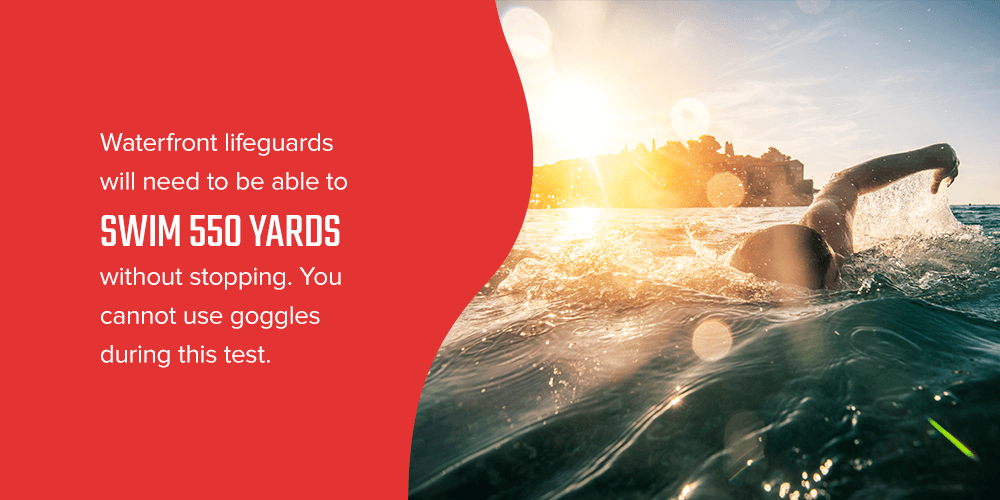
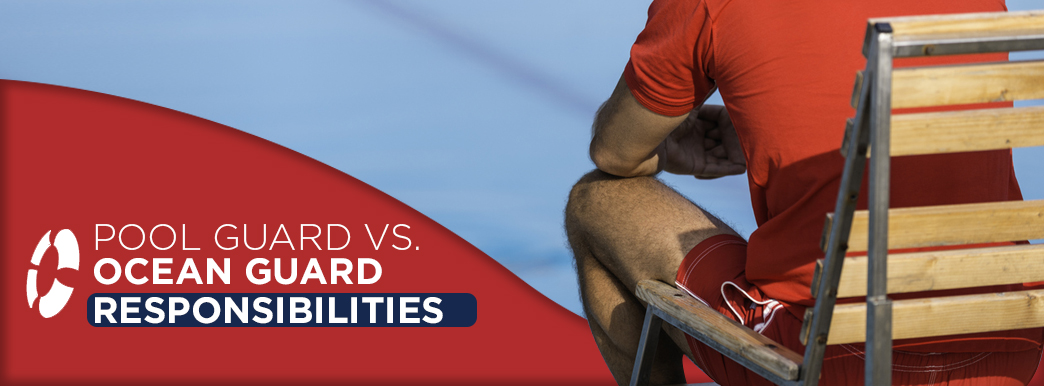
Pools, water parks and beaches employ lifeguards because they are vital to keeping swimmers safe. All lifeguards are trained to monitor the water, perform rescues and to administer first aid and CPR as needed. But, the specific training for lifeguards varies depending on where they work.
A pool lifeguard and an ocean lifeguard work in very different settings, which means you must complete and meet different requirements to become a certified lifeguard for either environment.
What Is a Pool Lifeguard?
Pool lifeguards are trained to work at human-made swimming facilities, either indoors or outdoors. You will see pool lifeguards on the job at community pools, private pools, health clubs and water parks. This type of lifeguard is trained to monitor pools and is certified in CPR and first aid. All training and certification take place in a classroom environment and a pool.
Pool Lifeguard Responsibilities
Becoming a pool lifeguard offers many advantages. You'll develop skills and improve your confidence while working with others in a pool environment. You will have many lifeguard duties and responsibilities, including the following tasks.
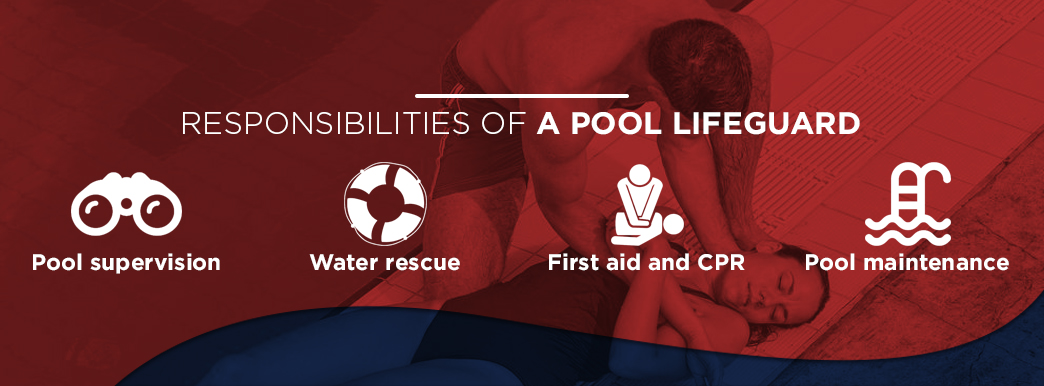
Lifeguarding at a pool comes with a lot of responsibilities, including:
- Pool supervision: The majority of your time as a pool lifeguard will be spent monitoring the water. You will likely be assigned to a specific section. You will be trained to watch for swimmers in distress. Throughout the day, you may rotate posts with other lifeguards on staff, but the bulk of the job will be spent carefully watching the water and the people in it. It is important to remain focused so you can enforce pool rules designed to keep people safe and respond in the event of an emergency.
- Water rescue: Water rescue is one of the most crucial skills taught to a pool lifeguard. Emergencies may be rare, but you need to know how to respond to one and quickly. A person of any age can drown in a matter of seconds. Pool guards are responsible for getting in the water, reaching the person in distress and quickly getting them out of the water. These lifeguard duties require the use of rescue gear, such as ring buoys, rescue tubes, throw bags and rescue cans. You will be trained to use these devices to pull a drowning victim to safety without compromising your own safety.
- First aid and CPR: Accidents can happen at pools. People slip on the pool deck, or someone starts to struggle in the water. As a pool lifeguard, you are trained to respond to these situations with first aid and CPR skills. You will be responsible for responding to minor slips and falls with first aid kits available at the pool. You also need to know how to handle accidents, such as a head or back injury, until professional medical help arrives. In the case of drowning, most victims will require immediate medical attention. Pool guards are certified in CPR to help drowning victims while waiting for 911 to dispatch help to the pool. Lifeguards will also be trained to use automated external defibrillators (AEDs).
- Pool maintenance: Swimming pool lifeguards also play an active role in pool maintenance. You may be responsible for maintaining the proper level of chemicals in the pool water and keeping areas like the pool deck and locker rooms clean.
What Is an Ocean and Beach Lifeguard?
An ocean and beach lifeguard undergoes a slightly more rigorous training and certification regimen than pool lifeguards because of the different working environment. Beach lifeguards work outdoors on a natural body of water, often an ocean. This environment is more unpredictable than a pool. Ocean lifeguards are trained to work in water that comes with waves, riptides and the potential for bad weather. Just like pool guards, ocean lifeguards will also be trained and certified in CPR and first aid. Final certification will take place outdoors at a beach.
Beach and ocean lifeguards often look out for a greater number of people than pool lifeguards because there is more space for people to gather on the beach.
Responsibilities of an Ocean/Beach Lifeguard
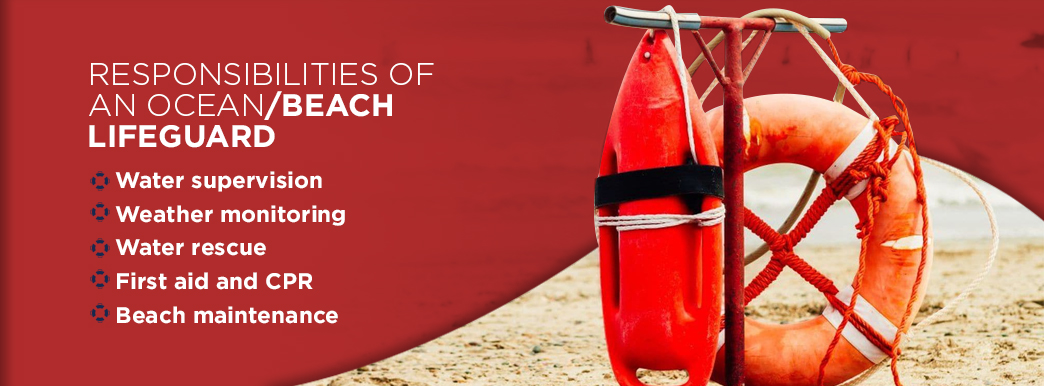
Pool lifeguards and beach lifeguards share the responsibility of swimmer safety, but the unpredictability of the ocean adds more complexity to lifeguarding on the beach. Ocean lifeguarding responsibilities include:
- Water supervision: Ocean lifeguards will spend most of their time watching the water to ensure swimmer safety. Your assigned post may have you walking up and down a sandy stretch of beach, or you may be assigned to a tower that gives you an elevated vantage point over the waves. Some beaches also post lifeguards out on the water in boats to ensure swimmers do not pass safety checkpoints and swim out too far or into dangerous areas of the water. Enforcing beach rules, such as where to swim and how far, is another important part of the job. With constant supervision, lifeguards can keep beachgoers safe while they have fun in or around the water.
- Weather monitoring: Ocean lifeguards and lifeguards at outdoor pools share this responsibility to an extent. Swimming outdoors becomes dangerous during lightning storms, and lifeguards need to be prepared to empty the pool and let swimmers know about potentially dangerous weather conditions. Ocean lifeguards have the added responsibility of understanding wind conditions and communicating this to beachgoers. Is the wind creating dangerous wave conditions? Are there any riptides that swimmers need to be aware of at the beach? Beach lifeguards may have radios to communicate with one another, and megaphones to communicate with swimmers. The beach tends to be a larger environment than a pool. If weather conditions change and make being in the water dangerous, beach lifeguards may also be responsible for changing the flags that many beaches put out to indicate the water conditions. The flags let beachgoers know if swimming is safe or not.
- Water rescue: Beach lifeguards will learn how to perform water rescues, just like pool lifeguards, but they will need to use those skills in different conditions. Ocean rescues mean navigating potentially hazardous water conditions, as well as regular waves. Ocean lifeguards will use the same type of rescue equipment (buoys, rescue cans and throw bags), but they may also be trained to incorporate different kinds of boats into their rescue skill set. Ocean lifeguards may spend more time training to ensure they completely understand the key elements of open-water rescues and can perform them at a moment's notice. Strong swimming skills are crucial when serving as an ocean lifeguard. The wave's natural force can make swimming and rescuing more challenging, so consistent practice with your equipment in the ocean is vital.
- First aid and CPR: Like pool lifeguards, ocean lifeguards are certified in first aid and CPR. As an ocean lifeguard, you are responsible for responding to emergency medical situations. On the beach, that could mean minor cuts and abrasions due to natural beach detritus. It could also mean responding to head injuries, especially on rocky beaches. In the case of a drowning victim, ocean lifeguards are trained to provide CPR until professional medical help arrives. Both pool lifeguards and ocean lifeguards will be trained to use an AED. Having these skills is crucial to being an effective lifeguard. You never know what accidents will happen or when they'll occur, so the mandatory training you receive for first aid and CPR will come in handy.
- Beach maintenance: Beach maintenance may be a small part of an ocean lifeguard’s job. You might clean up debris washed ashore, pick up after beachgoers and help clean beach facilities. Taking care of the beach ensures people can continue enjoying it. While your primary duties as a lifeguard will take precedence, spending some time maintaining the beach can give you a break and help you move around a bit if you've been sitting in the tower for a while.
Pool Guard vs. Ocean Guard: Certification Requirement Differences
Ocean lifeguard certification and pool lifeguard certification differ in a few ways, specifically the swimming distances and retrieval tests you must complete during testing.
1. Pool Lifeguard Certification Requirements
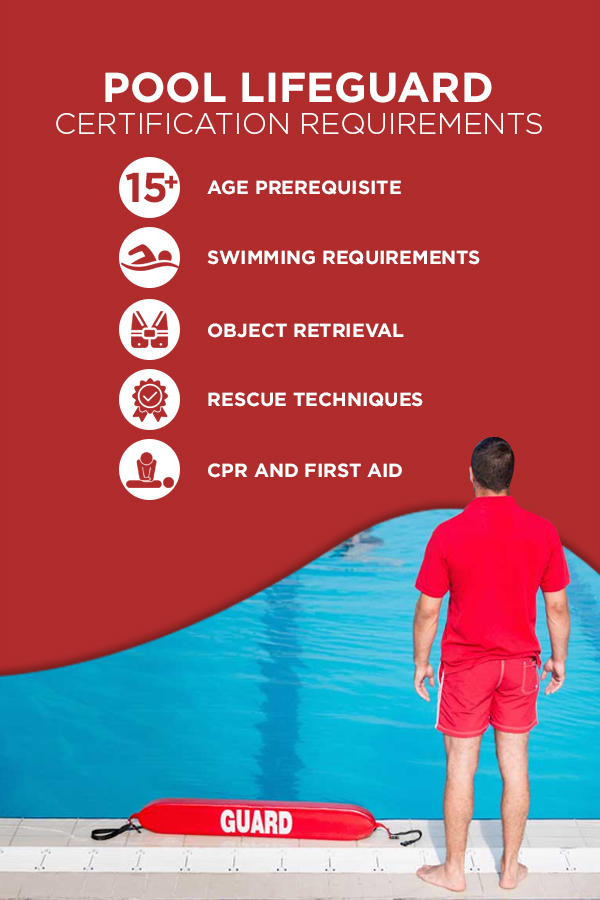
Swimming pool lifeguard requirements include:
- Age prerequisite: Before you can even begin to train as a lifeguard, you need to meet certain prerequisites. You must be 15 years old at the time of training or turn 15 years old by the time the training course is complete.
- Swimming requirements: Swimming skills are, of course, essential to becoming a trained lifeguard. Candidates are required to swim 300 yards without stopping. While you swim, you must be able to demonstrate proper breathing techniques. During this portion of the lifeguard training test, you can swim freestyle or breaststroke. You will also need to demonstrate the ability to tread water for two minutes without using your arms.
- Object retrieval: This part of lifeguard training is often referred to as the brick test. You will also need to retrieve an object, usually a 10-pound rubber brick, submerged at seven to 10 feet beneath the water. You will not be able to use goggles. You will start at the edge of the pool and execute a surface dive into the water, swim 20 yards and then swim downwards to grab the brick. Once you surface, you will need to keep the brick out of the water with two hands, swim back to the edge of the pool and exit the pool without using a ladder. You will have one minute and 40 seconds to complete this part of the test.
- Rescue techniques: You will need to pass a professional rescuer test to become a fully certified lifeguard. You will learn how to use different rescue gear and how to respond to swimmers in distress safely. You will need to demonstrate these rescue skills to gain lifeguard certification.
- CPR and first aid: Lifeguards-in-training will also learn how to administer CPR and first aid. This training will prepare you to respond to all sorts of different situations, such as breathing emergencies, back injuries, head injuries, heart attacks, bites and stings, and more.
Certification will involve in-person instruction and tests of skills in the water. You will also need to complete a written exam. Some training courses offer a blend of in-person and online instruction. Candidates must receive a passing grade on the written test to earn certification. Once you earn your lifeguard certification, you can apply to different pools to become a pool lifeguard.
2. Beach Lifeguard Certification Requirements
Ocean lifeguard certification demands strong swimming skills. Before taking on waterfront skills training or surf lifeguard training, you will already need to be a certified lifeguard, which means you need to demonstrate all of the pool lifeguarding skills and show certification of that test. Here is what it takes to become an active-duty lifeguard on the ocean:
- Age prerequisite: Waterfront lifeguard training requires candidates to be at least 15 years of age. If you are taking this skills course along with basic lifeguard training, you will need to be 15 years old by the completion of the course.
- Swimming requirements: Waterfront lifeguard training is a bit more rigorous than pool lifeguard training, which means the test of your swimming skills will be more challenging. Waterfront lifeguards will need to be able to swim 550 yards without stopping. You can swim freestyle, breaststroke or a combination of the two. You cannot use goggles during this test. Candidates in training to become surf lifeguards will need to be able to swim 500 meters in the ocean within 10 minutes.
- Object retrieval: In addition to the brick test, you will also have to complete a ring retrieval test. Three different dive rings will be placed in four to seven feet of water and five yards apart. You will be required to swim from five yards away, dive down to retrieve the rings and swim five yards to exit the water. Surf lifeguard training requires candidates to pass the brick test, but the brick will be placed on the bottom of the ocean floor.
- Running test: As a surf lifeguard, you will likely be working on a sandy beach. Running on sand can be more challenging than running on a flat surface, so this is incorporated into your training and certification. The running test will have short-distance and long-distance components. You will need to be able to run approximately a quarter of a mile for the short-distance part of the test and up to a mile for the long-distance part of the test.
- Rescue techniques: Due to the unpredictable nature of ocean water, beach lifeguards are more likely than pool lifeguards to be called upon to rescue swimmers. A large portion of your time in surf lifeguard training will be spent learning how to use rescue gear to respond to various swimmer-in-distress situations safely. You will need to demonstrate those skills adequately to become officially certified.

To secure your waterfront lifeguard certification, you must also complete educational courses to prepare you for the job, including:
- CPR and first aid: Waterfront and surf lifeguards will need to have the same CPR and first aid knowledge as pool lifeguards. This means knowing how to respond to all kinds of emergency medical situations and using emergency equipment such as an AED or a bag valve mask. With proper education and training, you'll be able to aid anyone in distress.
- On-the-job training: Being an ocean lifeguard is challenging. Certification may get you ready for a job, but you will likely be pushed to maintain and improve your skills while you work. This might mean training with your coworkers, including swims, runs and weight lifting. You may also learn how to paddle a boat, such as a kayak. If you are old enough and a licensed driver, you may even be assigned a beach vehicle on the job. You will be expected to periodically perform practice rescues with your coworkers and maintain the necessary knowledge of water and weather conditions at your beach.
Once you gain certification, you can begin looking for a job. Expect that some pools and beaches will include a test of the skills you learned during training as a part of the hiring process. You may need to take a timed swim test and complete the brick test again. Whether you are a pool lifeguard or a beach lifeguard (waterfront or surf), your certification will likely be good for two years. After that, you will need to become recertified.
Get the Ocean and Pool Lifeguarding Gear You Need
When you train to become a lifeguard, you want to make sure you have the right gear for the job. Lifeguards need a comfortable swimsuit that allows them to move easily and apparel for cooler days. Shop lifeguard swimwear and apparel at The Lifeguard Store. Whether you will be standing guard at a pool or on a beach, we have what you need to be prepared for the job.

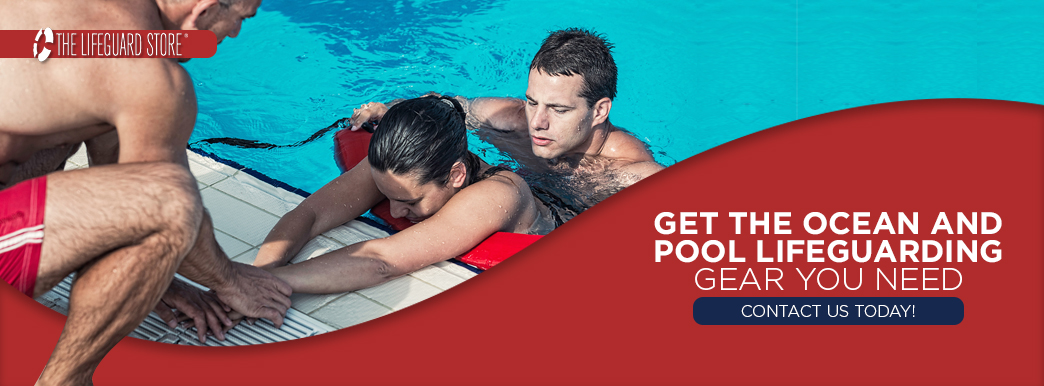


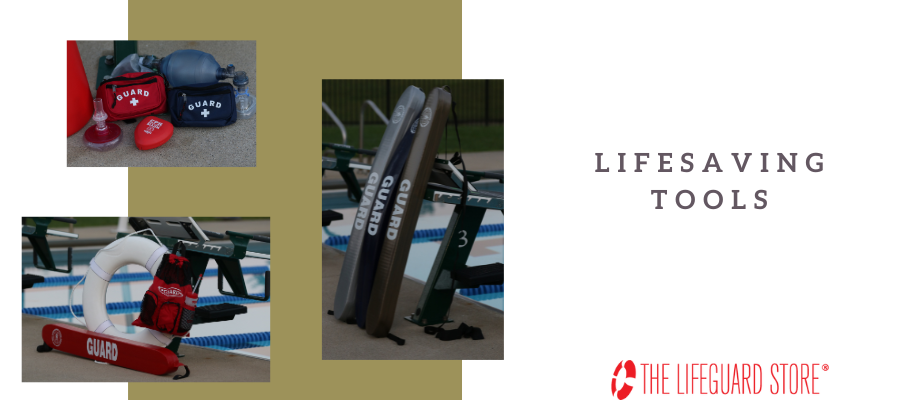
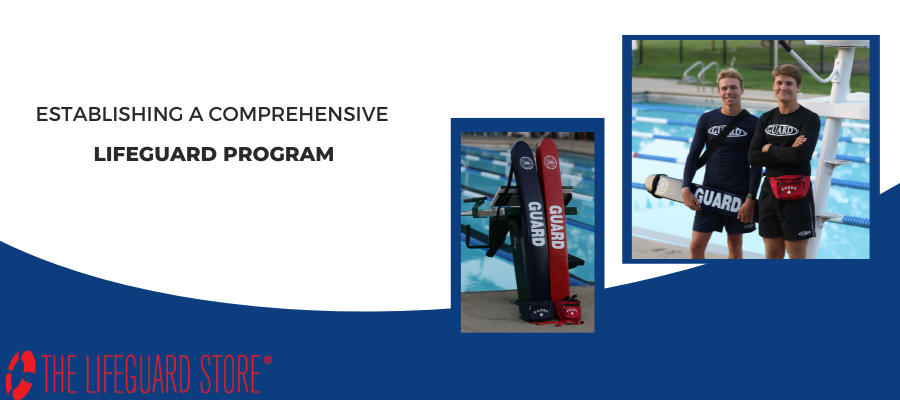
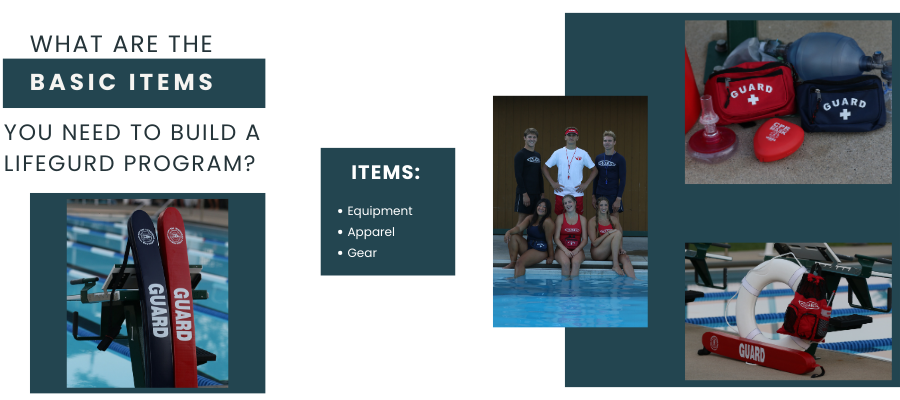
Leave a Comment
Your email address will not be published. Required fields are marked *